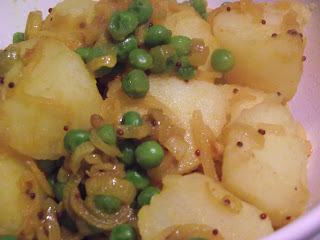We had my Dad over for lunch this Saturday and I decided to go for French – probably still my favourite kind of food if I had to choose. Much as I love Indian, Thai, Chinese, Spanish, Italian (to a point) and all things Middle Eastern, my last supper would be French, with wines to match. So this lunch menu included ham hock terrine with soused vegetables, duck breasts with cherry sauce and potatoes dauphinoise and lemon, orange and almond tart.
For the terrine I turned to Raymond Blanc for guidance, from his latest book Kitchen Secrets. I didn’t follow the recipe slavishly but the general gist is there – I didn’t use enough gelatine so the set was a little softer than I wanted but the flavour was delicious, and the soused vegetables set it all off beautifully.
The tart recipe comes from Mireille Johnston’s French Cookery Course Part 1. She had two television series in the early 1990’s and both books are very useful additions to the cook’s library, packed with regional French dishes. The television programmes were lovely, it's a shame they have never been repeated - my ex had quite a crush on Ms Johnston!
For the terrine I used my Le Creuset terrine dish. http://www.lecreuset.com/nl-be/Export-Products/Cast-Iron-Cookware/Oven-Dishes/Terrine-rectangulaire-28cm I bought it years ago so that I could make an iced orange souffle from the La Potiniere cookbook. The Potiniere was a near legendary restaurant in Gullane, East Lothian (near Edinburgh) where there was a three year waiting list for Saturday dinner. It was run by husband and wife team David and Hilary Brown (he did front of house and wine, she cooked) and they offered a fixed menu - no choice at all - and only opened for lunch time four times a week and Saturday evening. Their book, http://www.amazon.co.uk/Potiniere-friends-Hilary-Brown/dp/0712620435 gives a flavour of what it was all about. The restaurant is still there but no longer run by the Browns. I was forunate enough to have had two memorable lunches there.
But enough reminiscing.....
Ham Hock Terrine
1 ham hock (or knuckle) approx. 2.5kg in weight
A bouquet garni comprising 2 bay leaves, parsley and thyme
10 black peppercorns
10 g leaf gelatine
1 carrot diced
10 sprigs flat leaf parsley
Soused vegetables
400ml water
80ml white wine vinegar
80 g honey
Pinch white pepper
Large pinch sea salt
Sprig of thyme
1 bay leaf
100g carrots cut into 4cm sticks
100g cauliflower cut into small florets
60g cornichons
Put the ham hock into a large saucepan, cover with cold water, bring to the boil and skim off any scum. Bring down to simmer and add the bouquet garni and black peppercorns. Simmer for 2 ½ to 3 hours until ham is coming off the bone.
Remove hock from pan, leave to cool and strain liquor and reserve 500 ml. The rest can be used as a base for soup etc. Remove meat from hock, taking care to remove most of the fat, tendons, membranes etc. Reserve six large pieces of ham and chop the rest roughly.
Cook the carrot until just tender, strain and allow to cool. Chop the parsley finely.
Soak gelatine leaves in cold water for ten minutes then add to the warm ham cooking liquor.
Line the terrine with a double layer of cling film. Put in a layer of chopped ham, then half the chopped parsley, half the carrot, the large pieces of ham in a single layer, the rest of the carrot, then the parsley, then the rest of the chopped ham. Pour over the ham liquor until the level of liquor rises above the ham.
Fold the cling film over and put the terrine in the fridge and cool for at least twelve hours.
To make the vegetables, put all sousing ingredients in a large saucepan and bring to boil. Add carrots and cook for 20 minutes, then add cauliflower and cook for a further ten minutes. Remove from heat. Cool rapidly and add gherkins.
Serve the terrine in thick slices with the soused vegetables and some good bread.
Tarte au Citron et a L’Orange
First a word of warning…when this goes in the oven it looks highly unlikely it will ever turn into something solid and edible. Just stick with it – it may need a little more cooking than the recipe says but once it has set to a wobble bring it out and let it cool. It will be wonderful…
I use jus-rol sweet pastry. I am perfectly capable of making it but I find this product so good I don’t see the point unless I am really in the mood….
I pack Jus-rol sweet pastry
For the filling
3 lemons
2 oranges
75g caster sugar
70g butter
2 eggs
4 tblsp sieved marmalade
25g flaked almonds
Icing sugar to dust
Roll the pastry out quite thinly and line a 23 cm loose bottom flan tine. Bake blind at 190 for 20 minutes until set and lightly browned.
Grate the rind from 1 lemon and 1 orange. Squeeze the juice from 2 lemons. Peel oranges and 1 lemon with a knife, cutting off the pith, then cut down through the membranes to release segments. Add any juice collected to the squeezed lemon juice.
Beat together the sugar, butter and orange and lemon rinds until light and fluffy, gradually beat in the eggs and then the lemon juice. It will all start looking curdled but don’t panic. Put the mixture into the pastry case, level off, and arrange the orange and lemon segments on top. Brush over with the warmed sieved marmalade and sprinkle with the almonds. Bake for at least 20 minutes at 190, but if it still looks too wet leave for another 10 minutes. Leave to cool in tin for at least 10 minutes then transfer to serving plate and dust with icing sugar just before serving.

































